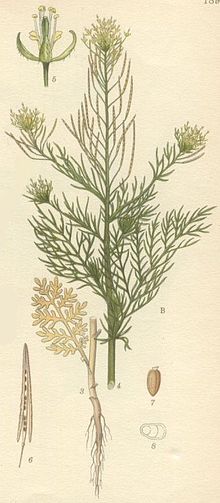Ordinary broom mustache
| Ordinary broom mustache | ||||||||||||
|---|---|---|---|---|---|---|---|---|---|---|---|---|

Common broom mustache ( Descurainia sophia ) |
||||||||||||
| Systematics | ||||||||||||
|
||||||||||||
| Scientific name | ||||||||||||
| Descurainia sophia | ||||||||||||
| ( L. ) Prantl |
The common broom mustache ( Descurainia sophia ), also called Sophia mustache , is a species of broom mustache ( Descurainia ) within the cruciferous family (Brassicaceae). The genus is only represented by this one species in Germany and Austria; around 47 species are known worldwide. The scientific generic name honors the French pharmacist and botanist François Descurain (1658–1749).
description
Vegetative characteristics
The common broom rag is an annual , herbaceous plant that usually reaches heights of between 25 and 100 centimeters. The bluish-green to gray-green stem grows upright. The leaves are bluish-green to gray-green. The stem leaves are divided into two or three pinnate sections and have linear tips.
Generative characteristics
The flowering period extends mainly from May to September. The flower stalks are twice to three times as long as the calyx. The hermaphrodite flowers are fourfold. The only 1.5 to 2 millimeters long, barely 1 millimeter wide, pale greenish to greenish-yellow petals are usually shorter than the sepals.
The one-nerved pods grow upward-curved, are 15 to 25 millimeters long and sit on much thinner, 7 to 15 millimeters long stems.
The number of chromosomes is 2n = 28.
ecology
It is mostly self-pollinating .
The many-seeded pods are self-spreading, wind and animal spreaders and winter cows. The seeds spread out as sticky.
Occurrence
The distribution area extends from all of Europe to Asia . The common broom must also be found in North Africa and even in Greenland . In Central Europe it is considered an archaeophyte . It is a neophyte in Australia, New Zealand, North America, South America, Hawaii, Japan, Korea and southern Africa .
The common broom must be found in eastern Germany and often found. In the other German areas it occurs rather scattered; it is rare in the mountains. In Austria, the common broom must be found very frequently in the Pannonian region , and it is also found rather scattered. In Switzerland, it grows quite frequently, especially in the warmer regions.
The common broom must grow in rubble weed communities and on dry slopes, on fields and on dry roadsides. It thrives best in more or less dry, nitrogen-rich and sandy soils . It is in Central Europe a local characteristic species of Sisymbrietum sophiae (Sisymbrion Association), but also comes in Onopordion companies before.
literature
- Henning Haeupler, Thomas Muer: picture atlas of the fern and flowering plants of Germany . Ed .: Federal Agency for Nature Conservation (= The fern and flowering plants of Germany . Volume 2 ). Eugen Ulmer, Stuttgart (Hohenheim) 2000, ISBN 3-8001-3364-4 .
- Wolfgang Adler, Karl Oswald, Raimund Fischer: Excursion flora of Austria . Ed .: Manfred A. Fischer. Eugen Ulmer, Stuttgart / Vienna 1994, ISBN 3-8001-3461-6 .
- Christian Heitz: School and excursion flora for Switzerland. Taking into account the border areas. Identification book for wild growing vascular plants . Founded by August Binz. 18th completely revised and expanded edition. Schwabe & Co., Basel 1986, ISBN 3-7965-0832-4 .
- Erich Oberdorfer : Plant-sociological excursion flora . With the collaboration of Theo Müller. 6th, revised and expanded edition. Eugen Ulmer, Stuttgart (Hohenheim) 1990, ISBN 3-8001-3454-3 .
- Konrad von Weihe (ed.): Illustrated flora. Germany and neighboring areas. Vascular cryptogams and flowering plants . Founded by August Garcke. 23rd edition. Paul Parey, Berlin / Hamburg 1972, ISBN 3-489-68034-0 .
- Ruprecht Düll , Herfried Kutzelnigg : Pocket dictionary of plants in Germany and neighboring countries. The most common Central European species in portrait . 7th, corrected and enlarged edition. Quelle & Meyer, Wiebelsheim 2011, ISBN 978-3-494-01424-1 .
Individual evidence
- ↑ a b Erich Oberdorfer : Plant-sociological excursion flora for Germany and neighboring areas . With the collaboration of Angelika Schwabe and Theo Müller. 8th, heavily revised and expanded edition. Eugen Ulmer, Stuttgart (Hohenheim) 2001, ISBN 3-8001-3131-5 , pp. 476 .
- ^ Descurainia in the Germplasm Resources Information Network (GRIN), USDA , ARS , National Genetic Resources Program. National Germplasm Resources Laboratory, Beltsville, Maryland. Retrieved July 25, 2017.
Web links
- Descurainia sophia (L.) Prantl, common besenrauke. In: FloraWeb.de.
- Distribution map for Germany. In: Floraweb .
- Ordinary broom mustache . In: BiolFlor, the database of biological-ecological characteristics of the flora of Germany.
- Descurainia sophia (L.) Prantl In: Info Flora , the national data and information center for Swiss flora . Retrieved October 29, 2015.
- Distribution in the northern hemisphere according to: Eric Hultén , Magnus Fries: Atlas of North European vascular plants 1986, ISBN 3-87429-263-0 .
- Thomas Meyer: Data sheet with identification key and photos at Flora-de: Flora von Deutschland (old name of the website: Flowers in Swabia )



